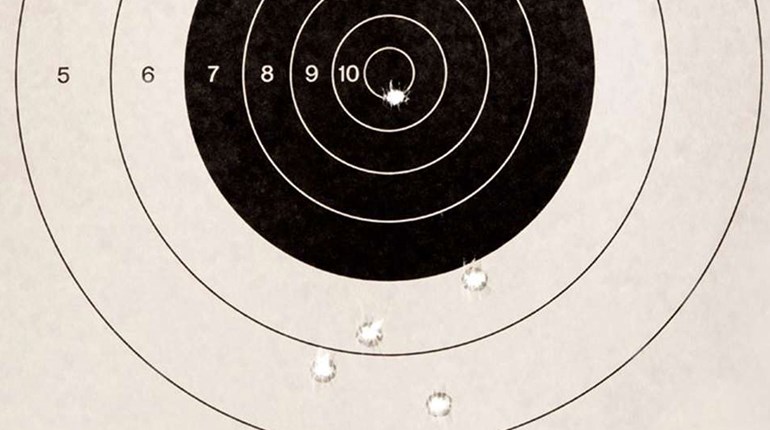
The Problem
You have taken precision-pistol courses, defensive-pistol courses, competition-pistol courses, rifle courses and even shotgun courses, all of which left you pondering the same question: How does one define acceptable accuracy with any or all of these guns? And what is the magic sight picture to achieve acceptable accuracy?
No one you have talked to has been able to offer a plausible answer that seemed to make sense. You are still in search of answers that are comprehendible and effective when implemented properly.
The Solution
Unfortunately, the most frequently taught, conventional-training methods for hitting a target or targets are sometimes counter-intuitive and in fact filled with unnecessary detail to meet the desired objective of acceptable accuracy. The two absolutes of getting shots on target—getting the muzzle pointed at the target and triggering the shot while the muzzle is on the target—are often taught from the perspective of precision shooting, which requires perfect sight alignment and sight picture accompanied by the slow and steady operation of the trigger until a surprise let-off occurs.
This is fine if you are shooting what used to be 2700 Bullseye Pistol competition, now referred to as Precision Pistol, where the X-rings are slightly less than 2 inches in diameter and the distances to the target are 25 and 50 yards.
But, what about shooting an IDPA target where the center (Down Zero) scoring area is 8 inches in diameter and is rarely shot beyond 15 yards? Or, what about shooting steel plates on a plate rack where a hit is a hit, no matter where the bullet impacts the target?
In each case, all the bullet has to do is hit the edge of the intended target area to achieve maximum value and success. When time is factored into the equation, whether it be in a defensive situation, competition or otherwise, the absolute precision placement of the bullet in the center of the target using perfect sight alignment and sight picture—along with the textbook manipulation of the trigger—might have to be compromised to achieve the best outcome.
Acceptable accuracy has as many definitions as there are shooters. It can be defined as the necessary accuracy to achieve the maximum benefit with a minimum of time and effort.
In the previous examples, absolutely perfect sight alignment, sight picture and trigger operation may not be necessary to achieve the desired hits on target for the intended result. The size of the target and the distance between the shooter and the target pretty much dictate how much attention to detail regarding the sights and the trigger is necessary to achieve acceptable accuracy.
In a defensive situation, where the target is likely in close proximity, time is of short duration and the event is likely to take place in diminished light, seeing only the outline of the gun within the outline of the target may be sufficient to deliver effective shots to the threat. This sight picture may be peripheral in nature, since the tendency is to have one’s eye focus on the object of threat when danger is sensed and not on the front sight, as some would have you believe is necessary to hit the target area.
In competitive shooting where time is a consideration, if the target is big enough or close enough, acceptable shots can be delivered to the desired location using eye/hand coordination and smooth manipulation of the trigger, effectively point shooting the target.
Where absolute precise accuracy is required, one’s eye focus must be on the front sight, which is centered in the rear sight opening and superimposed on the target area to get the best results.
Where speed may be an added concern, but absolute precision is not required to shoot an acceptable shot, just seeing the front sight through the rear sight opening—regardless of its alignment—will usually yield the results expected.
A step past that is seeing the outline of the gun superimposed and also centered on the outline of the target as the trigger is being pulled. Seeing the actual outline of the gun itself acts as the point of reference to the target to get the muzzle near the middle of the target as the bullet exits on its way to impact.
In answering your questions, acceptable accuracy is decided by you. I would add that your equipment should be capable of 100-percent hits in the desired target area, so the only variable is your ability to use the equipment. Understand that sight pictures are infinitely variable depending on the target to be engaged.
A simple drill to shoot—which will help to determine what your sight picture should be to achieve the desired accuracy—requires a pizza box and an 8-inch paper plate. Put the box on a target stand as a backer and center the paper plate on the box.
Start at 3 yards looking at the center of the plate and shoot five shots. The objective is to hit the plate. The outline of the gun should be well within the outline of the pizza box. Move back to 6 yards and repeat the exercise. The objective is to hit the plate and see the outline of the gun within the pizza box behind the paper plate. Continue moving back in 3-yard increments until hits on the paper plate start to diminish or the outline of the gun no longer falls within the outline of the pizza box. Whenever either of these conditions occur, the time has come to transition to using your iron sights in order to successfully achieve the desired hits on the target.
With that said, this drill will help you to define the acceptable sight picture necessary to achieve your definition of acceptable accuracy.



































